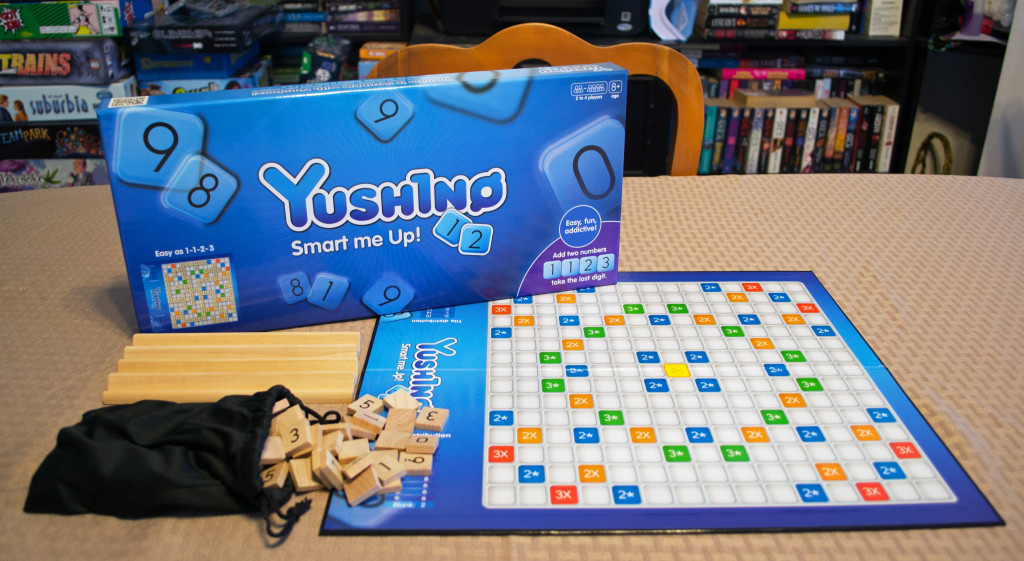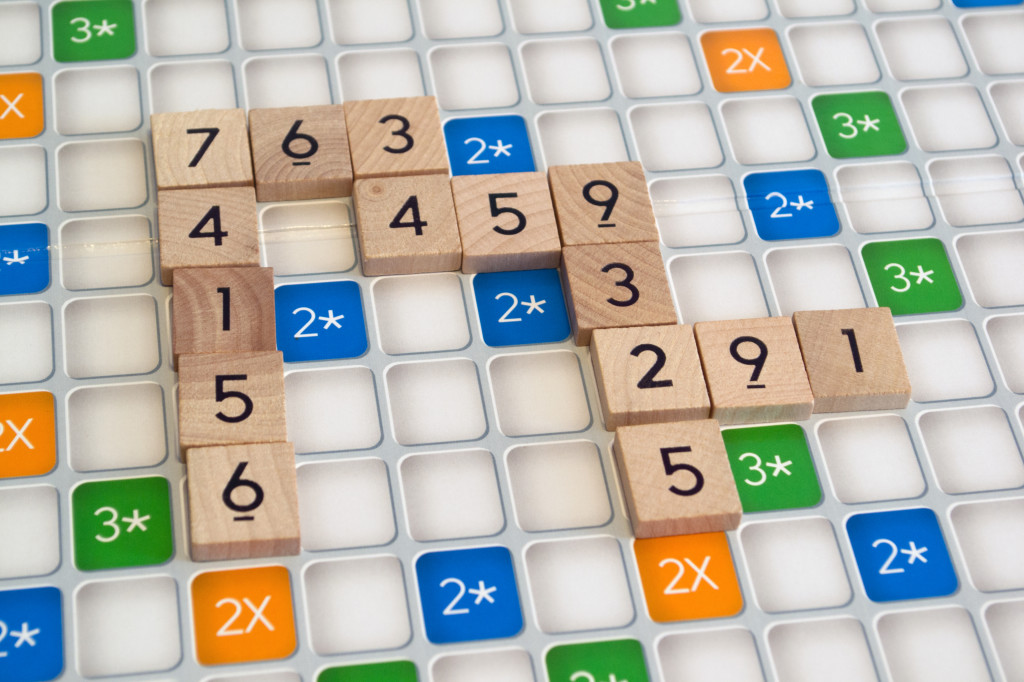I’ve been following “Yushino” ever since it was successfully funded through Kickstarter in September of 2013. In short, it’s “Scrabble” but with numbers. This crossword game will likewise test your math and number recognition skills as opposed to your spelling abilities. Originally, the developers wanted to name this game “Enable the Numbers”, but instead opted for a shorter name. Having used “Google Translate”, they came up with “Sūji o shiyō kanō ni” and took parts of it to come up with “Yushino”. I admittedly don’t speak Japanese, but the name is catchy enough. Before we get started, I’d like to thank Yiannis Tsiounis, the Founder & CEO of “Yushino”, for providing me with a free press copy.
Components
Board – The game includes a game board, most of which is comprised of a 15×15 square grid…that is, fifteen squares across by fifteen squares down. Some spaces have bonuses similar to that of “Scrabble” and award players points appropriately.
Tiles – Instead of letter tiles, you’ll find a variety of number tiles ranging from “0” to “9”. There are a few “blank” tiles that serve as wild tiles (players can assign any number they want when playing it).
Tile Tack & Bag – The tile racks allow players to hold their current “hand” of number tiles. The bag holds the pool of remaining tiles with which players can draw to refresh their hand.
Paper and Pencil (not included) – You’ll need something with which to keep score.
Setup & Gameplay
The board is placed in the center of the table within easy reach of all players. Next, the number tiles are placed into the bag and shuffled. Each player receives a tile rack and seven tiles from the bag. The starting player is chosen randomly, with play proceeding clockwise throughout the game. It’s important to note that the first player must make use of the center tile on the board in some way for their first move.
—
During a player’s turn, they’ll attempt to make a legal play (called a “Yushino number” or “Yushino sequence”). To do so, they’ll need to follow some rules:
1. Sequences are played left to right or top to bottom and must touch an existing sequence.
2. If the sequence has three or more numbers, then every number must be the sum of the previous two numbers (modulo 10). Mudolo 10 means that when you add the two previous numbers, you only look at the last digit. For example: 6+8 = 14…you’d only look at the 4. Other valid Yushino sequences are 875, since 8 + 7 = (1)5; 7291, as 7 + 2 = 9 and 2 + 9 = (1)1, etc.
3. If the sequence has 2 numbers, the numbers must differ by 1. Examples of valid two-number sequences are: 56, 87, 90, 09, 98, etc.
—
Once a player has played a legal sequence, they’ll calculate their score for that turn and note it on a nearby scoring pad (not included):
1. Any number on a 2* or 3* space is multiplied by the bonus value indicated.
2. The score for the play is equal to the sum of the numbers played. Make sure you include any bonuses from the 2* or 3* spaces first.
3. The 2X and 3X spaces multiple that sequence score by the bonus value indicated. Do this step last.
4. If a player uses all 7 of their numbers in a single turn, they are awarded a bonus of 100 points.
Once the above has been done (a player has played a legal sequence and scored it), the next player clockwise will attempt to do the same. The previous player will attempt to draw back up to their hand size of seven tiles if there are any tiles left in the bag. Alternatively, a player can “pass” and “exchange” tiles from the bag to form a new hand. The game continues until every player has played the tiles in their rack and there are no more tiles left in the bag, or when three consecutive “passes” have occurred. The player with the most points, wins the game!
The above doesn’t cover all of the rules found in the manual, but should give you an idea as to how the game is played. For more information, you can check out the official rules here:
http://www.yushino.com/official_yushino_rules.html
The Review
The components were on par with what I expected, what with the game drawing a lot of parallels to “Scrabble”. They were of fair quality but remained attractive enough to warrant a double-take from passersby, though I suspect that this was partially the result of the game looking like something they had already been familiar with. The rulebook was an easy read, though new players may want to give themselves some extra time to become acquainted with the concepts of what qualifies as a legal sequence.
Having played a lot of “Scrabble”, getting into this numbered crossword game was, for the most part, easy as “pi” (ba-dum-chh!). The hardest concept to wrap my head around was how the math was observed…that is, taking only the last value of the sum you created and using that number along with the previous one to continue the sequence, if possible. It might be easy to create a sequence of 842 (8+4=1(2)), for example, but the next value in that sequence would need to be a six (8426) as 4+2=6. The longer the sequence, the more numbers you’ll have to juggle in your head. I won’t lie, it can be challenging to come up with lengthy sequences as the combinations available with seven number tiles are quite vast.
Part of the draw here, I found, was that you didn’t need to know “Pythagorean theorem” or be familiar with “Sudoku” to play this game. With that said, our family is relatively good at math and I’m curious to see how adding different the game would be if we added say, subtraction or multiplication. I’m sure it’s possible, based on what we’ve experienced thus far. Along those lines, “Yushino” is great for players of all ages as you can make the game as easy or as difficult as you want it to be. Younger players can stick to two numbers so as to practice their sequencing while math-savy adults/kids can mess around with more than just addition. As such, “Yushino” truly is a fantastic family-friendly board game, one that I’d be hard-pressed not to recommend.
In addition to a tabletop platform ($25.00 as of 7/9/14), the game is free to play on Facebook, iTunes, and in a browser via the official website. If you’re hesitant to drop cash on the tabletop version, I urge you to check out the free electronic options to help you decide either way. Purchasing a tabletop version might seem odd when you can play the game online for free, but certain situations may warrant it. For example, do you often leave your kids in the care of a technologically inept grandparent who thinks computers are the work of the devil and need something to keep them occupied? Do you purposely plan a family game night to get away from technology for a while? In these cases, the tabletop version will fit the bill and then some.
Final Verdict: 8/10
—
You can learn more about, try out, and purchase “Yushino” by visiting the following websites:
http://www.yushino.com/index.html
https://apps.facebook.com/yushino/
https://itunes.apple.com/us/app/yushino/id556619109?ls=1&mt=8
—



Thanks for the review! The real appeal of the physical board is that you have to do your own math. There’s no computer to calculate the score for you 🙂
I LOVED this game on my phone!! I’m not able to find it electronically.. can you possibly help??